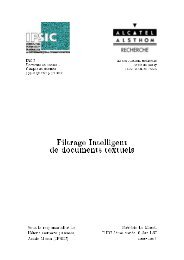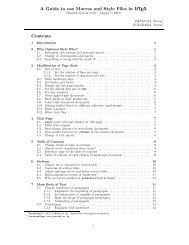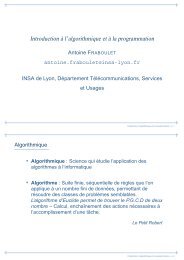Marine MINIER
Marine MINIER
Marine MINIER
Create successful ePaper yourself
Turn your PDF publications into a flip-book with our unique Google optimized e-Paper software.
Encadrements de Post-doctorat (1), MASTER (6), Stages doctoraux (2), Projetde n d'étude ingénieur (5) Encadrement de post-doctorant : Yuan Yuan ZHANG, Université de Shangai Jiao-Tong,(01/11/2010-01/04/2012). Thème de recherche : sécurité du codage réseau. Financement : surfond propre via la FFCSA (Fondation Franco-Chinoise pour la Science et ses Applications). Encadrement de stages doctoraux : Adil BENSLETEN (Université de Rabat), 3 mois en2006 et 6 mois en 2007 et Yves-Jonathan NDJE (3 mois en 2012). Encadrement de stages de MASTER2 (6) : Medhi DIOURI (02/2010-06/2010). Sujet : Proposition d'un mécanisme de lutte contre lesattaques Sybille dans les réseaux de capteurs sans l. Cherifa BOUCETTA (02/2010-06/2010). Sujet : La sécurité des systèmes de coordonnéesdans les réseaux de capteurs sans l. Ochirkhand ERDENE-OCHIR (02/2009-09/2009). Sujet : Résilience des protocoles de routagedans les réseaux de capteurs sans l. Paul FERRAND (02/2009-06/2009). Sujet : propriétés linéaires de l'AES et distingueurs àclés connus : applications aux fonctions de hachage. Bilel ROMDHANI (02/2008-06/2008). Sujet : Sécurisation d'un protocole de communicationpour réseau de capteurs sans l. Martin BOULANGER (02/2007-06/2007). Sujet : Sécurisation d'un protocole de communicationpour réseaux hybrides. Encadrement de stages de n d'étude ingénieur en relation avec la recherche(5) : Medhi DIOURI (06/2010-09/2010), Paul FERRAND (02/2009-06/2009), Dimitar DE-LOV (02/2009-06/2009), Tian-Qi ZHANG 02/2009-06/2009), Martin BOULANGER (06/2007-09/2007). Stage de 3ème année (2) : Mickael CAZORLA (06/2012-09/2012), Bertrand MANDRIN(06/2008-08/2008).
Participation à des Projets2011-2015 BLOC (ANR INS 2011) : Cette ANR-SETIN a pour objet le design et lesattaques des chirements par blocs dédiés aux environnements contraints. Jesuis coordinatrice de ce projet. (http://bloc.project.citi-lab.fr/).2010-2013 ARESA2 (ANR Verso, montant global : 1 513 211 euros) : Avancées en Réseauxde capteurs Ecaces, Sécurisés et Auto-Adaptatifs. L'INRIA via les équipesSWING et PLANETE est leader de la tâche 3. Je suis responsable de la rédactionde deux livrables (http://aresa2.minalogic.net/).2009-2012 CRE (Contrat de Recherche Externalisée) avec Orange Labs pour nancerl'encadrement de la thèse de Ochirkhand ERDENE-OCHIR sur les méthodes deroutage résilientes dans les réseaux de capteurs sans l.2007-2010 RAPIDE (ANR Setin 2006) : Cette ANR-SETIN avait pour objet la conceptionet l'analyse de chirements à ot ecaces pour les environnementscontraints. Je suis responsable du Workpackage Construction de MACs. (http://rapide-anr2006.gforge.inria.fr/).2008 Projet IXXI (nancé par l'IXXI) : évaluation expérimentale d'un modèle deconance pour les communautés ouvertes.2007-2008 PRIAM (Privacy Issues and AMbient intelligence) (ARC INRIA, Actionde Recherche Coopérative) : le but de ce projet était de créer une interactiondurable entre des juristes et des informaticiens an de dénir les dés de laprivacy au sein de l'intelligence ambiante.2007-2008 Malisse (Malicious sensors Context) (ARC INRIA, Action de RechercheCoopérative) : le but de ce projet était d'étudier les réseaux de capteurs et leursapplications en tenant compte de la présence de noeuds malicieux.2004-2007 KAA, Knowledge Authentication Ambient (ACI Securité Informatique2003) : Cette ACI multi-disciplinaire avait pour objet la construction de schémasde gestion de la conance socialement acceptables et informatiquement réalisables.(http://kaa.citi.insa-lyon.fr/). A mon arrivée à Lyon en 2005, j'aipris la responsabilité de cette ACI.2004-2005 Projet RNRT X-CRYPT : Outils cryptographiques adaptés aux réseaux detélécommunications à haut débit et aux réseaux sans l émergents (2003-2006).J'ai été ingénieur expert nancé par ce projet sur l'année universitaire 2004-2005.
Membre de Comités de Programme Membre des comités de programme de conférences internationales : FSE 2011, Indocrypt2009, ISPA 2007, WCC 2007. Et aussi : TOOLS 2010, MEDES 2010, CIS 2011, CIS2010, CIS 2009, IEEE ICDIM 2009, ICDIM 2008, MWNSW 2008. Membre des comités de programme de conférences nationales : Journées GDR C2 2011,Journées GDR C2 2005. relectrice pour les journaux Journal of Cryptology ; IEEE-IT ; Design, Codes and Cryptography; Information Processing Letters ; Computer Communications ; Performance Evaluation ;Discrete Mathematics & Theoretical Computer Science ; Telecommunication Systems. participation au site web de vulgarisation scientique picsi : http://www.picsi.org.Comités d'expert2011 Membre des comités de sélection du poste 63MC141 (Saint-Etienne) et duposte 27MC1064 (Nice).2010 Membre du comité de sélection du poste 63MC0511 (Saint-Etienne).2009 Membre des comités de sélection du poste 63MC0497 (Saint-Etienne) et duposte 27MC0226 (Limoges).Membre du comité de sélection des postes de CR1 et CR2 de l'UR INRIARhône-Alpes.Membre de jury de thèse Rapporteure de la thèse de Abdourhamane Idrissa, Université Jean Monnet - Saint-Etienne,Septembre 2012. Rapporteure de la thèse de Kaoutar Elkhiyaoui, Eurecomm - Télécom ParisTech, Septembre2012. Membre du jury de la thèse de Baudoin Collard, soutenue le 24 janvier 2011 à l'Université deLouvain-La-Neuve, Belgique. Sujet : Methods for Cryptanalysis of Block Ciphers. Jury : Pr.Jean-Jacques Quisquater (Promoteur), Pr. François-Xavier Standaert(Promoteur), Pr. <strong>Marine</strong>Minier, Pr. Vincent Rijmen, Pr. Eli Biham, Pr. Michel Verleysen (Président). Examinatrice (comme co-directrice) de la thèse de Benjamin Pousse, Université de Limoges,Décembre 2010. Examinatrice (comme co-directrice) de la thèse de Wassim Znaidi, INSA de Lyon, Octobre2010. Examinatrice (comme co-directrice) de la thèse de Samuel Galice, INSA de Lyon, Octobre2007.Responsabilités administratives2012 Participation à la rédaction du projet de création de l'équipe INRIA Privatics.2008-2010 Responsable de l'animation scientique du laboratoire CITI (organisation desséminaires internes et externes).2009-2011 Participation à la rédaction du projet de création de l'équipe INRIA SWING.Responsable de l'axe transversal Sécurité.Depuis 2005 Responsable de l'axe transversal Sécurité au laboratoire CITI.
The WSF : Challenging Empiresparliamentary democracy and liberal reform. A demand that the EU’s constitutioninclude ‘provisions to safeguard labour, environmental, health and education rights’ isin effect, demanding (without threat) that the master of capitalism in the EU reformitself — of course, it can’t. Wainwright’s desire that the ESF hold the EU to ‘account’masks the truth that the EU is the friend of the capitalist system that demands thedestruction of the earth, our rights, our liberties and freedoms. There is no way for theEU to be reformed, its undemocratic, anti-grassroots, authoritarian and centralisednature is directly opposed to all the demands of the anti-capitalist movement, even ifsome EU departments work towards progressive ends.Even more naively, Sousa Santos said that the only way to achieve a “true andindependent European identity was for the EU to clearly differentiate its socio-economicsystem from the US neoliberal model”, urging the rehabilitation of the state in economicaffairs. As if pre-World-War-One colonialism and the laissez-faire capitalism of nineteenthcentury European nation states were ultimately different from those of the US today,and that non-neoliberal capitalism was a solution to the problems of neoliberalism !The danger inherent in this approach is that it is self-destructive, ignoring the reasonsthat made the Forum possible in the first place.Potentially more troublesome tendencies within the liberal leadership of theESF are indicated by the symbolic dates for the meetings of the Forums — the samedates as the self-appointed global elite meet; this points to an even more impotent andself-destructive direction. When Pascal Lamy (EU Trade Commissioner) stated at aTABD dinner speech that the TABD “continues to put forward recommendations towhich governments on both sides of the Atlantic (will) do well listen carefully”. 18 USVice President Al Gore stated that of over a hundred recommendations put forward bythe TABD, over half had been implemented into law, wishing that the Senate was aseffective as this in drawing up legislation. 19 The most dangerous route that the leadershipof the ESF can take is to see the Forums as potential stronger negotiating partners forgovernment than the TABD or WEF. 20Instead, the ESF and WSF should see themselves as an embryonic form ofdirect, grassroots democracy, capable of forging ahead in gaining power throughundermining the legitimacy of existing structures of power, distributing this poweras widely and diffusely as possible.Attendance at the ESF — three times than expected — and the anti-warmarch that shocked Italy in its size, show that discontent is strong for a differentorder. The ESF is a chance for the Trade Union movement and anti-capitalist movementto create permanent links without the go-between of a political party, and to helppeople from all over the world with experiences of different struggles to come togetherand share ideas, tactics and strategy for change. The stale bureaucracy displayed insome sections of the leadership, and those who would divert the anti-capitalistmovement to further their own aims looked out of touch with the grassrootscomposition of the ESF. Jonathan Neale of Globalise Resistance (also a member ofthe SWP) told me that the leadership had been wholly reluctant to call an anti-wardemonstration from the start — because it would upset Berlusconi — and was farAbandon or Contaminate Linden Farrer173
Activités d'EnseignementSynthèse des Activités d'EnseignementDepuis mon recrutement à l'INSA de Lyon, j'eectue mes heures d'enseignements au département IF(informatique) et dans le MASTER MASTRIA, MASTER commun à l'INSA de Lyon et à l'UniversitéLyon 1. Sur une année, la synthèse de mes activités d'enseignement peut être découpée comme suit :Nature Niveau Nb heures ContenuCours magistraux L3 16h TD Théorie de l'Information, Cryptographie, ProbabilitésTD L3 50h TD Probabilités, Architecture Matérielle, CryptographieTP et projets L3 40h TD Architecture MatérielleTP et projets M1 50h TD RéseauxTP et projets L3 40h TD Analyse NumériqueCours M2 24h TD Cryptographie, SécuritéDétails des Activités d'Enseignement Depuis 2005, je suis responsables des cours de théorie de l'information, de cryptographie etde probabilités. Je fais partie des équipes pédagogiques : mathématiques et outils de modélisation, architecturedes ordinateurs et réseaux. Je participe à tous les jurys du département. J'ai rédigé et corrigé les sujets de devoirs surveillés pour les matières suivantes : probabilités,arithmétique pour la cryptographie à clé publique et théorie de l'information. Encadrement de stages : j'encadre chaque année environ 4 stages L3, 4 stages M1 et 2projets de n d'étude ingénieur.J'ai mis en place les enseignements suivants : Cours Magistraux (L3, 20h de Cours) : introduction à la théorie de l'information (64transparents), arithmétique pour la cryptographie à clé publique (64 transparents), probabilités(58 transparents) ; TP d'architecture matérielle (60h TP et 20h TD, L3) : Avec Christian Wolf et GuillaumeBeslon, nous avons monté un TP micromachine permettant aux étudiants de concevoir l'ALUet l'UC d'une micromachine 1 ; TP d'administration réseaux (60h TP, M1) : Avec Yves Boutemy, nous avons mis enplace un TP d'administration système sous Windows Server ; Cours de cryptographie et sécurité (24h, Cours, M2) : j'enseigne la cryptographie pourles réseaux sans ls pour le MASTER MASTRIA et l'option transversale Sécurité de 5èmeannée (250 transparents).Responsabilités d'enseignements 2012-... : Responsable du MASTER MASTRIA, spécialité Systèmes Informatiques et Réseaux,co-habilité par l'Université Lyon 1 et l'INSA de Lyon. 2005-2007 : Responsable de la gestion des stages de 3ème et 4ème année au département IF. 2008-2009 : Organisation de la visite du Data Center de IBM-Montpellier pour un grouped'étudiants de 5ème année.1. http://intranet-if.insa-lyon.fr/micromachine/
Détails des Activités de RechercheRésumé des Activités Scientiques DoctoralesCette partie décrit mes activités de recherche eectuées durant ma thèse (1999-2002) ainsi que durantles deux années (2002-2004) qui ont suivi. Ces recherches concernent essentiellement les chirementspar blocs utilisés en cryptographie symétrique.Rappelons tout d'abord qu'en cryptographie symétrique, pour que deux individus communiquententre eux sur un canal non sécurisé, il faut qu'il partage une même clé k servant à la fois au chirementet au déchirement. L'une des meilleures méthodes en matière de rapidité et de sécurité pour chirerdes messages en clé secrète est l'utilisation d'algorithmes de chirement par blocs. Ces algorithmesprennent en entrée/sortie des blocs de taille n bits et sont composés de r étages. À chaque étage,une même fonction paramétrée par une sous-clé k i est itérée. Les sous-clés sont diérentes à chaqueétage et générées à partir de la clé secrète k et d'un algorithme de génération de clés.L'essentiel de mes travaux doctoraux a porté sur l'étude de ces algorithmes d'un point de vuecryptanalytique. Nous avons monté deux attaques particulières contre les candidats AES (compétitionqui s'est déroulée de 1997 à 2000) Crypton et Rijndael (le futur AES) [45, 46]. L'attaque contrel'AES reste encore l'une des meilleures connues contre l'AES et fait l'objet d'un cours de troisièmecycle à l'université de Louvain. Nous avons également proposé une attaque [43] contre un schémade signature à clé publique nommé SFLASH utilisant les principes de la cryptographie multivariable.Cette attaque qui exploite une propriété particulière des espaces d'entrée/sortie a obligé lesconcepteurs de l'algorithme à modier ce dernier.Parallèlement, je me suis intéressée aux notions de pseudo-aléatoirité et de super-pseudoaléatoiritéservant de base au modèle de sécurité des algorithmes de chirement par blocs. Cesdiérentes études ont débouché sur de nouveaux résultats de sécurité [44].Résumé des Activités Scientiques au Laboratoire CITICette partie décrit mes activités de recherche eectuées durant mon poste d'ingénieur expert àl'INRIA Rocquencourt (2004-2005) ainsi que durant mes années comme maître de conférences aulaboratoire CITI (depuis 2005).Depuis 2004, je continue mon activité de recherche concernant la cryptographie symétrique enm'attachant plus particulièrement aux algorithmes de chirement à ot, aux algorithmes de chirementpar blocs et aux fonctions de hachage (notamment dans le cadre de la compétition du NISTSHA-3 (2007-2012)). Dans le cadre du projet ANR SETIN 2006 RAPIDE (2007-2010) et du coencadrementde thèse de Benjamin Pousse (laboratoire XLIM, Limoges) nancé par ce même projet,nous avons obtenu avec F. Arnault, T. Berger (du laboratoire XLIM, Limoges) et C. Laraudoux(équipe INRIA Privatics) un certain nombre de résultats clés concernant l'utilisation d'une représentationmatricielle pour les FCSR (Feedback with Carry Shift Register) et les LFSR (Linear FeedbackShift Register), briques de base fondamentales pour la construction d'algorithmes de chirement àot [14, 16, 27]. En ce qui concerne les algorithmes de chirement par blocs, nous avons, avec B.Pousse et R. Phan (Loughborough University), exploité des propriétés intégrales an de monter desdistingueurs dans les modèles dits à clés connues et à clés liées connues [11]. Nous avons égalementtrouvé le même type de propriétés contre 3 des candidats de la compétition SHA-3. Avec T. Peyrin(Nanyang Technological University, Singapore) et M. Naya-Plasencia (PRISM, Université de Versailles),nous avons également monté une attaque par rebond sur le candidat SHA-3 SHAvite-256an de générer des collisions sur une version réduite de la fonction de compression [19]. Depuis 2011,je suis coordinatrice du projet ANR 2011 INS BLOC (2011-2015) dont le but est d'étudier le design
et les attaques contre les chirements par blocs dédiés aux environnements contraints comme les tagsRFIDs ou les capteurs. Dans le cadre de ce projet, je co-encadre depuis novembre 2011 la thèse deGaël Thomas au laboratoire XLIM de Limoges avec T. Berger.A mon arrivée au laboratoire CITI, S. Ubéda m'a proposé de prendre la responsabilité du projetANR ACI Sécurité Informatique KAA (2004-2007) et de l'aider à encadrer la thèse de SamuelGalice nancé dans le cadre de ce projet. Ce projet multidisciplinaire avait pour objectif l'étude desmodèles de conance dans les réseaux ambiants. Nous avons donc cherché à développer avec l'aidede sociologues, d'économistes et de juristes un modèle de conance informatique qui soit socialementacceptable et économiquement viable. Nous avons nalement proposé le modèle KAA qui se fondesur des échanges qui ont eu lieu dans le passé et qui sont cryptographiquement vériables [36].Parallèlement à ce premier projet, depuis 2007, je m'intéresse à la sécurité dans les réseaux decapteurs sans l qui sont le domaine d'application privilégié du laboratoire CITI et qui lui vautsa reconnaissance internationale. Dans le cadre de la thèse de Wassim Znaidi nancée par la régionRhône-Alpes, nous avons proposé des solutions algorithmiques permettant de détecter ou de contournerun certain nombre d'attaques qui peuvent avoir lieu dans ces réseaux [33]. Nous avons égalementproposé des solutions cryptographiques permettant d'assurer l'authenticité et l'intégrité de donnéesagrégées ou combinées via du codage réseau [12]. C'est aussi sur ce thème et plus précisément sur lasécurité du codage réseau dans les réseaux de capteurs sans l [8] que travaillait Yuanyuan Zhang(Novembre 2010-Avril 2012) dont j'ai encadré le post-doctorat nancé par une bourse de la fondationfranco-chinoise FFCSA.Dans le cadre du projet ANR VERSO ARESA2 (2010-2013) et d'une collaboration avec OrangeLabs Grenoble qui nance la thèse d'Ochirkhand Erdene-Ochir, avec F. Valois du CITI et A. Kountouris(Orange Labs Grenoble), nous nous intéressons à la résilience des protocoles de routage dansles réseaux de capteurs sans l. Il s'agit de proposer des protocoles qui vont être intrinsèquementrésilients et vont donc continuer à router les paquets de données dans le réseau même en présenced'attaquants [7].Je viens également d'intégrer la nouvelle équipe INRIA Privatics bilocalisée entre Grenoble etLyon et dont le thème de recherche central est la protection des données de la vie privée. Desrésultats tant théoriques en cryptographie que pratiques en sécurité, sont bien sûr des éléments trèsimportants pour garantir la privacy dans les domaines qui représentent les nouveaux paradigmes del'informatique comme les bases de données, les réseaux ambiants ou les réseaux de capteurs sans l.
Liste Complète des PublicationsThèses et Habilitations[1] <strong>Marine</strong> Minier : Quelques résultats en cryptographie symétrique, pour les modèles de conancedans les réseaux ambiants et la sécurité dans les réseaux de capteurs sans l. Habilitation àDiriger des Recherches, Université Claude Bernard Lyon 1 et INSA de Lyon, France, mai 2012.[2] <strong>Marine</strong> Minier : Preuves d'Analyses et de Sécurité en Cryptologie à Clé Secrète. Thèse dedoctorat, Université de Limoges, France, 2002.Le projet européen eStream 2 qui fait partie du réseau d'excellence européen ECRYPT 3 a lancé unappel à soumission d'algorithmes de chirement à ot (2004-2008). Parmi les 23 candidats dédiés ausoftware et les 25 dédiés au hardware, une première phase a permis de pré-sélectionner 8 candidatsdans chaque catégorie. Un livre a été édité en 2008 contenant les 16 candidats restants après latroisième phase de sélection. Les deux chapitres suivants sont donc les deux propositions retenuesdans ce cadre. Une quatrième phase de sélection a eu lieu ensuite pour dénir le portfolio eStream,c'est-à-dire les algorithmes dont l'utilisation est recommandée par eStream. Ce portfolio ne contientpas Decimv2 comme candidat hardware mais Sosemanuk a été retenu comme candidat software.Chapitres de livre d'audience internationale[3] C. Berbain, O. Billet, A. Canteaut, N. Courtois, B. Debraize, H. Gilbert, L. Goubin,A. Gouget, L. Granboulan, C. Lauradoux, M. Minier, T. Pornin et H. Sibert :Decimv2. In M. Robshaw et O. Billet, éditeurs : New Stream Cipher Designs, volume 4986de Lecture Notes in Computer Science, pages 140151. Springer, 2008.[4] C. Berbain, O. Billet, A. Canteaut, N. Courtois, H. Gilbert, L. Goubin, A. Gouget,L. Granboulan, C. Lauradoux, M. Minier, T. Pornin et H. Sibert : Sosemanuk : a fastoriented software-oriented stream cipher. In M. Robshaw et O. Billet, éditeurs : New StreamCipher Designs, volume 4986 de Lecture Notes in Computer Science, pages 98118. Springer,2008.[5] YuanYuan Zhang, <strong>Marine</strong> Minier et Wassim Znaidi : Security FOR Network Coding. InKhaldoun Al Agha, éditeur : Network Coding, Chapitre de livre. ISTE Ltd and Wiley, 2012.Brevets[6] Apostolos KOUNTOURIS, Ochirkhand ERDENE-OCHIR, <strong>Marine</strong> <strong>MINIER</strong> et Fabrice VA-LOIS : Invention : Méthode résiliente à la présence des noeuds compromis pour la déterminationdes routes par un protocole de routage dans un réseau. brevet français N¦FR-11 58 828, Septembre2011.2. http://www.ecrypt.eu.org/stream/index.html3. http://www.ecrypt.eu.org/
Revues internationales[7] Ochirkhand Erdene-Ochir, Apostolos Kountouris, <strong>Marine</strong> Minier et Fabrice Valois : ANew Metric to Quantify Resiliency in Networking. Communications Letters, IEEE, à paraître,accepté en Août 2012, 2012.[8] YuanYuan Zhang et <strong>Marine</strong> Minier : How Network Coding System Constrains Packet PollutionAttacks in Wireless Sensor Networks. International Journal of Grid and Utility Computing,à paraître, accepté en Août 2012, 2012.[9] YuanYuan Zhang et <strong>Marine</strong> Minier : Selective Forwarding Attacks Against Data and ACKFlows in Network Coding and Countermeasures. Journal of Computer Networks and Communications,à paraître, accepté en Août 2012, 2012.[10] <strong>Marine</strong> Minier et María Naya-Plasencia : A related key impossible dierential attack against22 rounds of the lightweight block cipher LBlock. Inf. Process. Lett., 112(16):624629, 2012.[11] <strong>Marine</strong> Minier, Raphael C.-W. Phan et Benjamin Pousse : On Integral Distinguishers ofRijndael Family of Ciphers. Cryptologia, 36(2):104118, 2012.[12] Anya Apavatjrut, Wassim Znaidi, Antoine Fraboulet, Claire Goursaud, Katia Jaffrès-Runser, Cédric Lauradoux et <strong>Marine</strong> Minier : Energy ecient authentication strategies fornetwork coding. Concurrency and Computation : Practice and Experience, 24(10):10861107,2012.[13] Ochirkhand Erdene-Ochir, <strong>Marine</strong> Minier, Fabirce Valois et Apostolos Kountouris : EnhancingResiliency Against Routing Layer Attacks in Wireless Sensor Networks : Gradient-basedRouting in Focus. IARIA on-line journals, International Journal on Advances in Networks andServices, 4(1&2):3854, 2011. disponible en ligne http://www.iariajournals.org/networks_and_services/.[14] François Arnault, Thierry P. Berger, <strong>Marine</strong> Minier et Benjamin Pousse : RevisitingLFSRs for Cryptographic Applications. IEEE Transactions on Information Theory, 57(12):80958113, 2011.[15] Wassim Znaidi et <strong>Marine</strong> Minier : Key management and access control scheme for WSNs.Telecommunication Systems Journal, à paraître, accepté en Septembre 2010, 2010.[16] F. Arnault, T. P. Berger et M. Minier : Some Results on FCSR Automata with applicationsto the security of FCSR-based pseudorandom generators. IEEE Trans. on Inf. Theory, 54(2):836841, 2008.[17] Samuel Galice, <strong>Marine</strong> Minier et Stéphane Ubéda : The KAA Framework : A History-BasedTrust Establishment in Ambient Networks. IJICS - International Journal of Intelligent Controland Systems, Special Issue on Information Assurance, 12(4):331340, 2007.Conférences internationales avec Comité de Lecture et Actes[18] Thierry P. Berger, Jorey D'Hayer, Kevin Marquet, <strong>Marine</strong> Minier et Gaël Thomas :The GLUON Family : A Lightweight Hash Function Family Based on FCSRs. In Progress inCryptology - AFRICACRYPT 2012, volume 7374 de Lecture Notes in Computer Science, pages306323. Springer, 2012.[19] <strong>Marine</strong> Minier, María Naya-Plasencia et Thomas Peyrin : Analysis of Reduced-SHAvite-3-256 v2. In Fast Software Encryption - FSE 2011, volume 6733 de Lecture Notes in ComputerScience, pages 6887. Springer, 2011.
[20] <strong>Marine</strong> Minier et Raphael C.-W. Phan : Energy-Ecient Cryptographic Engineering Paradigm.In Open Problems in Network Security - IFIP WG 11.4 International Workshop, iNetSec2011, volume 7039 de Lecture Notes in Computer Science, pages 7888. Springer, 2011.[21] Yuanyuan Zhang, Wassim Znaidi, Cédric Lauradoux et <strong>Marine</strong> Minier : Flooding attacksagainst network coding and countermeasures. In 5th International Conference on Network andSystem Security, NSS 2011, pages 305309. IEEE, 2011.[22] <strong>Marine</strong> Minier, Raphael C.-W. Phan et Benjamin Pousse : Integral Distinguishers of SomeSHA-3 Candidates. In Cryptology and Network Security - CANS 2010, volume 6467 de LectureNotes in Computer Science, pages 106123. Springer, 2010.[23] Chérifa Boucetta, Mohamed Ali Kâafar et <strong>Marine</strong> Minier : How Secure are Secure LocalizationProtocols in WSNs ? In Sensor Systems and Software - Second International ICSTConference, S-Cube 2010, volume 57 de Lecture Notes of the Institute for Computer Sciences,Social Informatics and Telecommunications Engineering, pages 164178. Springer, 2010.[24] Ochirkhand Erdene-Ochir, <strong>Marine</strong> Minier, Fabirce Valois et Apostolos Kountouris :Resiliency of wireless sensor networks : Denitions and analyses. In Telecommunications (ICT),2010 IEEE 17th International Conference on, pages 828835. IEEE, april 2010.[25] Ochirkhand Erdene-Ochir, <strong>Marine</strong> Minier, Fabirce Valois et Apostolos Kountouris :Toward Resilient Routing in Wireless Sensor Networks : Gradient-Based Routing in Focus. InSensor Technologies and Applications (SENSORCOMM), 2010 Fourth International Conferenceon, pages 478483. IEEE, july 2010.[26] Anya Apavatjrut, Wassim Znaidi, Antoine Fraboulet, Claire Goursaud, Cédric Lauradouxet <strong>Marine</strong> Minier : Energy Friendly Integrity for Network Coding in Wireless SensorNetworks. In Fourth International Conference on Network and System Security, NSS 2010,pages 223230. IEEE Computer Society, 2010.[27] François Arnault, Thierry P. Berger, Cédric Lauradoux, <strong>Marine</strong> Minier et BenjaminPousse : A New Approach for FCSRs. In Selected Areas in Cryptography - SAC 2009, volume5867 de Lecture Notes in Computer Science, pages 433448. Springer, 2009.[28] Thierry Berger, <strong>Marine</strong> Minier et Benjamin Pousse : Software oriented stream ciphers basedupon FCSRs in diversied mode. In Progress in Cryptology - INDOCRYPT 2009, volume 5922de Lecture Notes in Computer Science, pages 119135. Springer, 2009.[29] Gérald Gavin et <strong>Marine</strong> Minier : Oblivious Multi-variate Polynomial Evaluation. In Progressin Cryptology - INDOCRYPT 2009, volume 5922 de Lecture Notes in Computer Science, pages430442. Springer, 2009.[30] Wassim Znaidi, Cédric Lauradoux et <strong>Marine</strong> Minier : Aggregated authentication (AMAC)using universal hash functions. In International ICST Conference on Security and Privacy inCommunication Networks - SecureComm 2009, volume 19 de Lecture Notes of the Institute forComputer Sciences, Social Informatics and Telecommunications Engineering, pages 248264.Springer, 2009.[31] <strong>Marine</strong> Minier, Raphael C.-W. Phan et Benjamin Pousse : Distinguishers for Ciphers andKnown Key Attack against Rijndael with Large Blocks. In Progress in Cryptology - AFRI-CACRYPT 2009, volume 5580 de Lecture Notes in Computer Science, pages 6076. Springer,2009.[32] Wassim Znaidi, <strong>Marine</strong> Minier et Stéphane Ubéda : Hierarchical node replication attacksdetection in wireless sensors networks. In Proceedings of the IEEE 20th International Symposiumon Personal, Indoor and Mobile Radio Communications, PIMRC 2009, pages 8286. IEEE, 2009.
[33] Wassim Znaidi, <strong>Marine</strong> Minier et Jean-Philippe Babau : Detecting wormhole attacks inwireless networks using local neighborhood information. In Proceedings of the IEEE 19th InternationalSymposium on Personal, Indoor and Mobile Radio Communications, PIMRC 2008,pages 15. IEEE, 2008.[34] Samuel Galice et <strong>Marine</strong> Minier : Improving Integral Attacks Against Rijndael-256 Up to 9Rounds. In Progress in Cryptology - AFRICACRYPT 2008, volume 5023 de Lecture Notes inComputer Science, pages 115. Springer, 2008.[35] François Arnault, Thierry P. Berger, Cédric Lauradoux et <strong>Marine</strong> Minier : X-FCSR -A New Software Oriented Stream Cipher Based Upon FCSRs. In Progress in Cryptology - IN-DOCRYPT 2007, volume 4859 de Lecture Notes in Computer Science, pages 341350. Springer,2007.[36] Samuel Galice, <strong>Marine</strong> Minier et Stéphane Ubéda : A trust protocol for community collaboration.In Joint iTrust and PST Conferences on Privacy, Trust Management and Security -IFIPTM 2007, volume 238 de IFIP Advances in Information and Communication Technology,pages 169184. Springer, 2007.[37] Samuel Galice, <strong>Marine</strong> Minier et Stéphane Ubéda : Gestion de la conance dans les communautésouvertes. In Conférence Internationale sur les NOuvelles TEchnologies de la REpartition- NOTERE 2007, 2007.[38] Nicolas Fournel, <strong>Marine</strong> Minier et Stéphane Ubéda : Survey and Benchmark of StreamCiphers for Wireless Sensor Networks. In Information Security Theory and Practices - WISTP2007, volume 4462 de Lecture Notes in Computer Science, pages 202214. Springer, 2007.[39] Samuel Galice, Véronique Legrand, <strong>Marine</strong> Minier, John Mullins et Stéphane Ubéda : AHistory-Based Framework to Build Trust Management Systems. In Second International Conferenceon Security and Privacy in Communication Networks and the Workshops - SecureComm2006, pages 17. IEEE, 2006.[40] Samuel Galice, <strong>Marine</strong> Minier, John Mullins et Stéphane Ubéda : Cryptographic Protocolto Establish Trusted History of Interactions. In Security and Privacy in Ad-Hoc and SensorNetworks - ESAS 2006, volume 4357 de Lecture Notes in Computer Science, pages 136149.Springer, 2006.[41] Thierry P. Berger et <strong>Marine</strong> Minier : Two Algebraic Attacks Against the F-FCSRs Usingthe IV Mode. In Progress in Cryptology - INDOCRYPT 2005, volume 3797 de Lecture Notesin Computer Science, pages 143154. Springer, 2005.[42] <strong>Marine</strong> Minier : A Three Rounds Property of the AES. In Advanced Encryption Standard -AES 2004, 4th International Conference, volume 3373 de Lecture Notes in Computer Science,pages 1626. Springer, 2004.[43] Henri Gilbert et <strong>Marine</strong> Minier : Cryptanalysis of SFLASH. In Advances in Cryptology- EUROCRYPT 2002, volume 2332 de Lecture Notes in Computer Science, pages 288298.Springer, 2002.[44] Henri Gilbert et <strong>Marine</strong> Minier : New Results on the Pseudorandomness of Some BlockcipherConstructions. In Fast Software Encryption - FSE 2001, volume 2355 de Lecture Notes inComputer Science, pages 248266. Springer, 2002.[45] <strong>Marine</strong> Minier et Henri Gilbert : Stochastic Cryptanalysis of Crypton. In Fast SoftwareEncryption - FSE 2000, volume 1978 de Lecture Notes in Computer Science, pages 121133.Springer, 2001.[46] Henri Gilbert et <strong>Marine</strong> Minier : A Collision Attack on 7 Rounds of Rijndael. In AESCandidate Conference, pages 230241, 2000.
Workshops internationaux avec Comité de Lecture et Actes[47] <strong>Marine</strong> Minier et María Naya-Plasencia : Some Preliminary Studies on the DierentialBehavior of the Lightweight Block Cipher LBlock. Workshop on Lightweight Cryptogrpahy2011, November 2011. Louvain, Belgique.[48] Benjamin Pousse et <strong>Marine</strong> Minier : Construction of FCSR algebraic equations and empiricalanalysis. SASC 2008 - Stream Ciphers Revisited, February 2008. Special Workshop hosted bythe ECRYPT Network of Excellence.[49] C. Bryce, M. Dekker, S. Etalle, D. Le Métayer, M. Minier et S. Ubéda : UbiquitousPrivacy Protection. In Fifth Workshop on Privacy in Ubicomp, 2007.[50] François Arnault, Thierry P. Berger et <strong>Marine</strong> Minier : On the security of FCSR-basedpseudorandom generators. SASC 2007 - Stream Ciphers Revisited, February 2007. SpecialWorkshop hosted by the ECRYPT Network of Excellence.[51] Samuel Galice, Véronique Legrand et Stéphane Ubéda <strong>Marine</strong> Minier, John Mullins : Modelizationand trust establishment in ambient networks. International Symposium on IntelligentEnvironment, Cambridge, April 2006. poster, 5 pages.[52] C. Berbain, O. Billet, A. Canteaut, N. Courtois, B. Debraize, H. Gilbert, L. Goubin,A. Gouget, L. Granboulan, C. Lauradoux, M. Minier, T. Pornin et H. Sibert :Decimv2. SASC 2006 - Stream Ciphers Revisited, February 2006. Special Workshop hosted bythe ECRYPT Network of Excellence.[53] C. Berbain, O. Billet, A. Canteaut, N. Courtois, B. Debraize, H. Gilbert, L. Goubin,A. Gouget, L. Granboulan, C. Lauradoux, M. Minier, T. Pornin et H. Sibert : Decim :a new stream cipher for hardware applications. http://www.ecrypt.eu.org/stream/, 2005.Call for Stream Cipher Primitives, Network of Excellence in Cryptology ECRYPT.[54] C. Berbain, O. Billet, A. Canteaut, N. Courtois, B. Debraize, H. Gilbert, L. Goubin,A. Gouget, L. Granboulan, C. Lauradoux, M. Minier, T. Pornin et H. Sibert : Decim :a new stream cipher for hardware applications. In Proceedings of SKEW - Symmetric KeyEncryption Workshop, Network of Excellence in Cryptology ECRYPT, mai 2005. http://www2.mat.dtu.dk/people/Lars.R.Knudsen/stvl/.[55] C. Berbain, O. Billet, A. Canteaut, N. Courtois, H. Gilbert, L. Goubin, A. Gouget,L. Granboulan, C. Lauradoux, M. Minier, T. Pornin et H. Sibert : Sosemanuk : a fastoriented software-oriented stream cipher. http://www.ecrypt.eu.org/stream/, 2005. Call forStream Cipher Primitives, Network of Excellence in Cryptology ECRYPT.[56] C. Berbain, O. Billet, A. Canteaut, N. Courtois, H. Gilbert, L. Goubin, A. Gouget,L. Granboulan, C. Lauradoux, M. Minier, T. Pornin et H. Sibert : Sosemanuk : a fastoriented software-oriented stream cipher. In Proceedings of SKEW - Symmetric Key EncryptionWorkshop, Network of Excellence in Cryptology ECRYPT, mai 2005. http://www2.mat.dtu.dk/people/Lars.R.Knudsen/stvl/.Rapports Techniques et de Recherche[57] Ochirkhand Erdene-Ochir, <strong>Marine</strong> Minier, Fabrice Valois et Apostolos A. Kountouris :Resilient networking in wireless sensor networks. Rapport technique, INRIA, 2010.[58] Cédric Lauradoux et <strong>Marine</strong> Minier : A Mathematical Analysis of Prophet Dynamic AddressAllocation. Report de Recherche RR-7085, INRIA, 2009.
[59] <strong>Marine</strong> Minier et Benjamin Pousse : Improving Integral Cryptanalysis against Rijndael withLarge Blocks. Rapport de Recherche, INRIA, 2009.[60] Wassim Znaidi, <strong>Marine</strong> Minier et Jean-Philippe Babau : An ontology for attacks in wirelesssensor networks. Rapport technique, INRIA, 2008.[61] Samuel Galice, Véronique Legrand, <strong>Marine</strong> Minier, John Mullins et Stéphane Ubéda :The KAA project : a trust policy point of view. Rapport technique, INRIA, 2006.[62] <strong>Marine</strong> Minier : A Bottleneck Attack on Crypton. INRIA research report, number 5324,october 2004. 12 pages.


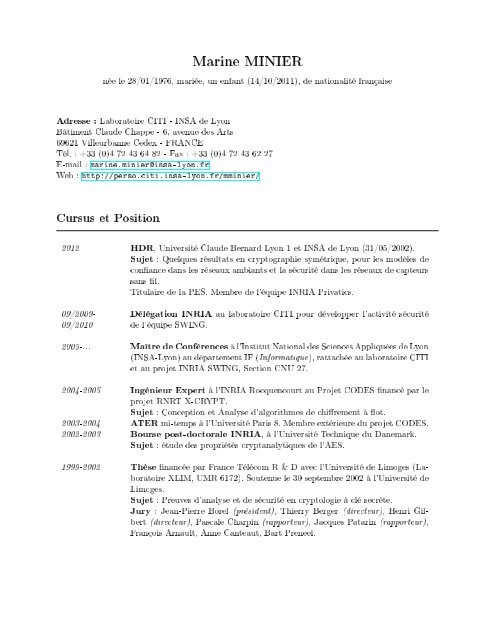
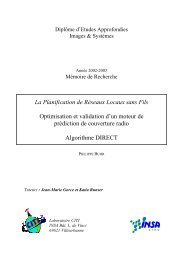

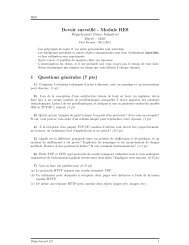

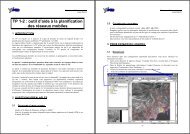
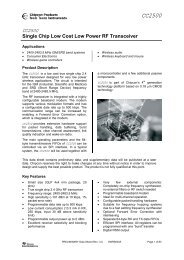
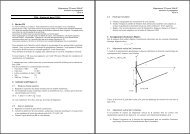
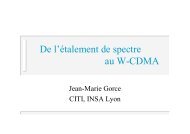
![td-res-4 [Compatibility Mode]](https://img.yumpu.com/45826987/1/184x260/td-res-4-compatibility-mode.jpg?quality=85)
